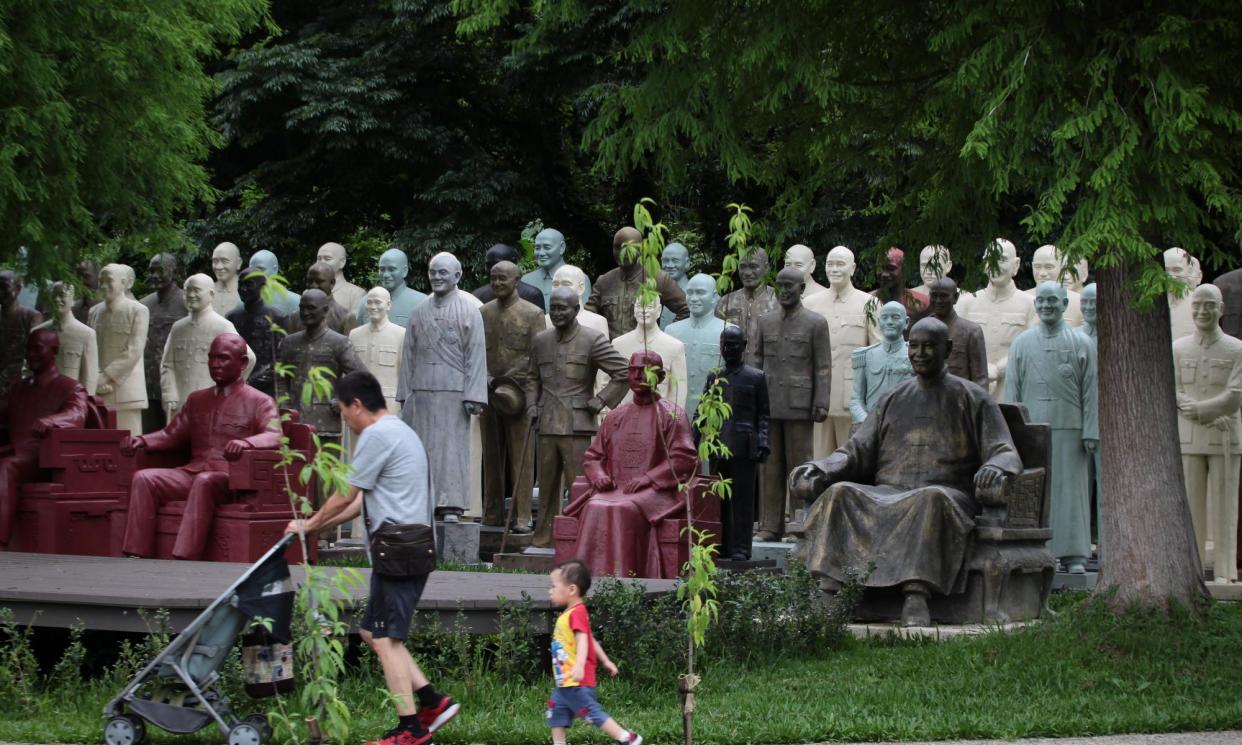‘Ghostly’: Taiwan park dotted with hundreds of statues of late dictator as row rages over their fate

The last time Mrs Hsieh came to Cihu Park in Taoyuan was almost 50 years ago, on a school trip to the grave of Taiwan’s recently deceased dictator. Busloads of children were brought in to pay their respects to Chiang Kai-shek, known as Generalissimo, who had died at 87, after decades ruling the island under brutal martial law.
“There were a lot of buses, and there was a long queue,” Hsieh recalled. “It was a school rule. We had to bow, and then we went home.”
Chiang’s body is still there, under guard in a mausoleum at the end of a path that winds through misty bamboo past a still lake broken only by light drizzle and a drifting swan. But the other end of the park is the truly ghostly part, dotted as it is with hundreds of statues, almost all of Chiang.
Some stand in a circle – a group of Chiangs gathered for a casual conference or a campfire chat. Elsewhere, dozens are lined up in what looks like a choir of Chiangs. There is Chiang on a horse, Chiang in a seat, Chiang reading a book or holding a hat. A few have Chiang surrounded by adoring children, and paths are lined with his busts on concrete pedestals. Almost all the Chiangs wear his famous smile.
There were no statues here in the 1970s, says Hsieh. They have been moved here over time, taken from public spaces but not destroyed, standing here as an uncanny honour guard around the mausoleum.
“It’s a strange place,” says Hsieh. “There are so many statues. It would be scary at night.”
The veneration shown to Chiang when Hsieh was a child is no longer a given. Chiang was the ruler of the Republic of China until he and his Kuomintang (KMT) party were driven out by the communists in China’s civil war. They and millions of supporters retreated to Taiwan in 1949, establishing the ROC in exile, with Chiang planning to retake the mainland one day. Under his almost-four-decade-rule – now known as the “white terror” – an estimated 3,000-4,000 people were executed and 140,000 imprisoned for actual or perceived opposition to the KMT.
After his death in 1975, Taiwan transitioned to a democracy, and criticism of the leadership present and past became possible. But Chiang’s legacy is still fervently debated here.
In 2018, the ruling Democratic Progressive party (DPP), which was born of the opposition to martial law, established a transitional justice commission to investigate and atone for the KMT’s acts against Taiwan’s people. In 2022, a subsidy programme offered grants of up to 100,000 Taiwan dollars (£2,500) for local authorities to change or remove “authoritarian symbols” to help end a “culture of political veneration”.
Taiwan has more than 300 roads named after Chiang, almost 60 schools, and dozens of localities, including the central district of Taipei. A handful have changed name in the past five years: a road in former capital Tainan is now named after a prominent victim of the massacre of February 1947, when thousands of protesters were killed by KMT troops.
If Chiang hadn’t come to Taiwan, it would probably be ruled by the Communists now, and most Taiwanese do not want to be governed by Xi Jinping
Mr Huang
Last week, a DPP legislator challenged the government on its slow progress over the more than 700 statues that are still standing, saying it should be more proactive in encouraging take-up of the subsidies. Cabinet official Shih Pu said part of the issue was that many of the statues were on military sites, which did not want to remove them.
The modern KMT party, now in opposition, has apologised for past acts but opposes the DPP’s transitional justice efforts, which it says amount to a political witch-hunt. Some members have likened a proposal to remove the largest Chiang statue – a six-metre-high sculpture in central Taipei –to the Taliban’s destruction of the Buddhas of Bamiyan in 2001
Opinions in the country are divided but nuanced. Prominent campaigner Lin Li-cai , whose father was a victim of the massacres, told the Observer her family will “set off firecrackers” if the Taipei statue is removed. But some say Chiang’s crimes must be balanced against the economic boom he ushered through, and his fight against the Japanese and the communists.
“Chiang did a lot of controversial things,” park visitor Mr Huang said. “But he also made contributions. If he hadn’t come to Taiwan back then, it would probably be ruled by the communists now, and most Taiwanese do not want to be governed by Xi Jinping.”
Hsieh says there’s no point erasing history, and the statues look OK where they are in schools. Also, she adds, laughing, Cihu park is spooky enough. It doesn’t need any more.


